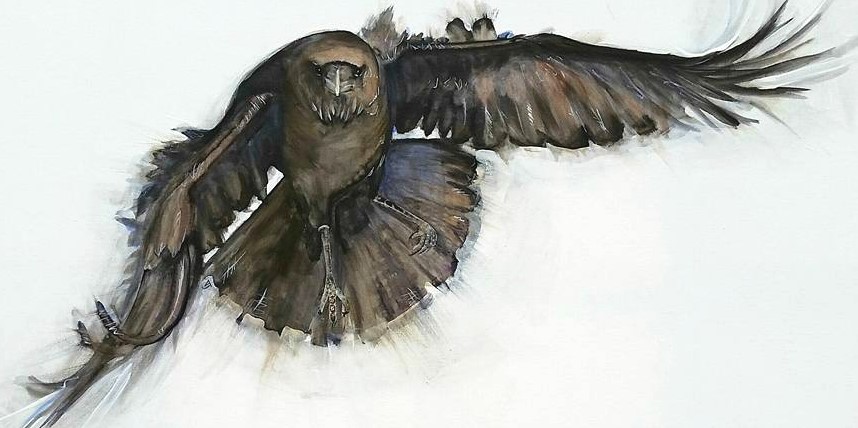The old Idiom Theater is undergoing a transformation into the Artists 12 Pop-up Gallery. This is a new space for our Pop Up Gallery Group (Artists 12). We have been busy transforming this space into an art experience. We'll be ready for the Downtown Art Walk this Friday: August 5th 6pm-9pm - 1418 Cornwall Avenue, Bellingham WA. (down the hall from Allied Arts Gallery).
I will have fresh pieces inspired by my recent trip to the north end of the Salish Sea. These small pieces each represent a location, and the flora and fauna that impressed me from that location.
Remember we are up for one night only and then we disappear until our next surprise show. See you there!
A Journey Through the Salish Sea
This group of paintings were created this summer as my family and I journeyed around the northern extent of the Salish Sea. We spent a month tucked in little harbors and bays in Desolation Sound aboard our boat Misogi. We are no strangers to the aquatic world as my husband, son and I live aboard a 54’ wooden trawler in Squalicum Harbor.The Salish Sea is the unified bi-national ecosystem that includes Washington State’s Puget Sound, the Strait of Juan de Fuca and the San Juan Islands as well as British Columbia’s Gulf Islands and the Strait of Georgia. The name recognizes and pays tribute to the first inhabitants of the region, the Coast Salish. It is internationally governed as it crosses the international boundary between the United States and Canada. The Salish Sea is one of the world’s largest and biologically rich inland seas. Here are a few interesting facts about the Salish Sea:
- Coastline length, including islands: 7,470 km
- Total number of islands: 419
- Maximum depth: 650 meters
- Number of different marine animal species estimated at 37 species of mammals, 172 bird species, 247 fish species, and over 3000 species of invertebrates
- Number of species listed as threatened, endangered or are candidates for listing: 113
Grace Bay Dragon, 6"x 6" acrylic on wood cradle.
Grace Bay is a very secluded bay off the Malaspina Inlet. The harbor is located in the Desolation Sound Marine Park and is located on the mainland. There are no roads into this area. Grace Bay is quiet and totally secluded. The cedars and firs come down to the waterline. A small trail leads from the bay to Black Lake. This lake is a wetland wonderland with black, tannic water and dragonflies filling the sky. This painting is of a female Western Pondhawk (the males are blue). It took a liking to my son and was often resting on our boat.
In the summer months the birding in Desolation Sound kind of quiet. Most the water birds are off to islands such as Midtlenatch Island to raise families. One of the most commonly seen species this time of year is the Marbled Murrelet, which I find strange as it is a very endangered species in our area. This spunky little sea birds feed of small forage fish such as herring and smelt. They work in pairs to capture fish from large schools found in the area. A strange behavior of this bird is this totally aquatic bird nests on large branches of conifers (often many miles from the water). It was so good to see these birds looking so healthy here.
One our favorite islands is Cortes Island. This island is populated and can be reached by ferry. It reminds me of what the San Juan’s used to be like. Gorge Harbor is located on the western side of the island is a deep harbor accessed through a narrow passage with high steep walls (think Lord of the Rings). There are a couple islands within the harbor. It is a wonderful place to visit and walk the roads and trails. One of the distinctive birds in this place is the Oyster Catcher. They are a comical bird with stunning orange beaks and legs that seem to not know how to be quiet. You can hear them calling constantly during the day. They feed along the tideline on limpets, small oysters and such.
Below the Tideline, Desolation Sound, 8"x 8" acrylic on canvas. .
One of the notable things about Desolation Sound is the water gets very warm (up to 80F at the surface) due to warm temperatures and poor circulation. This results in a very limited intertidal community. This painting focuses on the most noticeable intertidal life: Rockweed. Rockweed is a brown algae that is found everywhere in this area. It glows a golden yellow color that I love against the often white grey rock. Critters such as pipefish and whelks can be found among it.
Ganges Harbor Heron, 8"x 8" acrylic on canvas. .
As we headed home we spent a few days in Ganges Harbor. This busy little harbor is on Salt Spring Island in the Gulf Islands (south of Desolation Sound). We found a spot at the Government Warf for the boat and were entertained by the bustle of sea plane and boat traffic. As busy as the harbor is there are plenty of Great Blue Herons foraging for small fish between the boats and on the docks.






